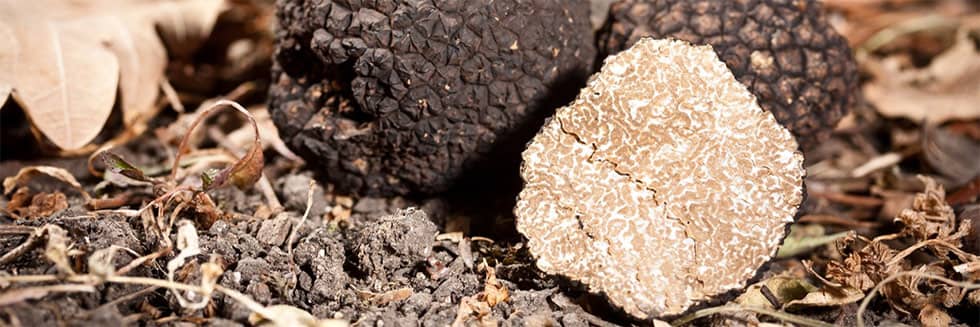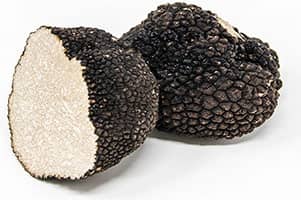
Where and how to produce summer truffles ?
Summer truffle characteristics
 The summer truffle, also called "sun truffle" or "aoustenque" in Provence, belongs to the Tuberaceae family. This edible mushroom is called "hypogeous" because it grows underground. It is also a "mycorrhizal" mushroom, which means that the truffle lives in symbiosis with a host tree, usually a holm oak or a white oak.
The summer truffle, also called "sun truffle" or "aoustenque" in Provence, belongs to the Tuberaceae family. This edible mushroom is called "hypogeous" because it grows underground. It is also a "mycorrhizal" mushroom, which means that the truffle lives in symbiosis with a host tree, usually a holm oak or a white oak.
Tuber aestivum is characterized by its spherical or oblong shape of brown color. Its irregular surface is pitted with protruding, prismatic or pyramidal warts. Its flesh is white inside when it is not ripe, then yellowish, and turns to hazelnut beige when ripe, crossed with white and very fine veins. It is because of this clear flesh that it is also called "white summer truffle". Be careful not to confuse it with the very rare and sought-after Italian white truffle.
Its fragrance is more subtle than its cousin the winter truffle (or black truffle of Périgord). It gives off more nuanced flavors and leaves a small taste of hazelnut and roe particularly pleasant. If some consider it too tasteless, others on the contrary underline its subtlety and its sweetness. Black truffles ripen at the end of spring and are harvested from May to the end of August (exceptionally until September).
Soils and climates suitable for the summer truffle growing
The summer truffle establishes itself and develops under the same tree species and on the same types of soil as those where black truffles grow, but during the summer season. It prefers soils rich in calcium and magnesium, granular and full of small inclusions. The soils favorable to Tuber Aestivum are alkaline or sub-alkaline, with the presence of exchangeable calcium, balanced texture, lumpy structure, well drained, mineral composition with no deficiency or excess of major elements and trace elements.
Soils favorable to the development of Tuber aestivum
The summer truffle requires a calcareous soil with a pH between 7 and 8. The organic matter content must be balanced and the C/N (carbon/nitrogen) ratio can reach 20. The clay content can be higher than for Tuber melanosporum without exceeding 40%.
We remind you that each truffle species has specific requirements. Therefore, we advise you to do a soil analysis to check if your land is suitable for truffle growing and to define the most suitable truffle species. We can arrange for this analysis to be carried out by our partner, the Teyssier laboratory, which specializes in soil analysis for truffle growing.
Preferential climate for the summer truffle
The summer truffle grows in drier areas than its cousin Tuber Uncinatum, in Mediterranean or even oceanic climates. Its main climatic danger occurs when a period of dryness and heat quickly follows an episode of frost (which does not happen so frequently)... In terms of topography and orientation, we prefer plateaus and gentle slopes, all exposures combined, with a slight preference for the South-East, North-East and East.
Irrigation and water needs of the summer truffle
Like any mushroom, the summer truffle needs water especially during its development. But in order to grow normally, it needs water and humidity in the right quantity: in case of excess of water, it dies, and on the contrary, in case of prolonged drought, it has difficulties to grow.
Mycorrhization of forest plants by the summer truffle
Spontaneously, several species of forest trees can live in symbiosis with the summer truffle. If the most known is the oak, it is also possible to produce summer truffles from other host species such as hazelnut, hornbeam, or cistus. Indeed, each of these species responds favorably to controlled mycorrhization so that you now have the possibility to grow summer truffles from mycorrhized plants.
If the most used host species for the culture of summer truffles remains the truffle oak, Robin Nurseries offers you a much wider range of host species. This wide choice of ROBIN TRUFFLE PLANTS allows us to adapt to the different constraints and conditions encountered in the field (climate, exposure, altitude, hygrometry...).
Below, you will find all the host species proposed by ROBIN Nurseries after mycorrhization with the summer truffle :
Thanks to their high level of performance, these plants allow you to produce your own summer truffles. Please note that depending on the age of the plant and the land chosen for its implantation, you will have to wait between 5 and 8 years to harvest your first summer truffles.
ROBIN TRUFFLE PLANTS mycorrhized with summer truffles are available in ROBIN ANTI-CHIGNON® buckets of 0.43 liters. These are high quality plants produced in our nursery by techniques developed within the framework of our quality system and under license from INRAE (National Research Institute for Agriculture, Food and the Environment).
You hesitate between several plants? You are not sure to choose the most suitable host species for your truffle plantation project? For the realization of your summer truffle orchard, do not hesitate to contact the sales manager of your sector, he will be able to advise you and accompany you step by step.
10 questions/answers about growing summer truffles
The summer truffle is generally found at the foot of holm oaks, but also under lime, poplar or hazelnut trees, between 200 and 1,000 meters in altitude, in the southern regions of France (Provence and even Périgord).
Tuber aestivum grows naturally in many regions, starting with the south of France. It is also widespread in other countries such as Italy, Hungary and Greece.
Tuber aestivum seems to have two fruiting periods: a first one in mid-February (which corresponds to the truffles harvested in May), followed by a second main fruiting stage in early spring which results in the harvest generally staggered between June, July and August.
Several tree species allow the production of summer truffles. Holm oaks and white oaks are excellent candidates, as well as hazelnut and hornbeam, provided that these plants are previously mycorhized and controlled with tuber aestivum.
Depending on the host species of the chosen plant (oak, hazelnut, hornbeam, cistus...) and its age, the price of a truffle plant mycorhized with summer truffle varies from 12 € to about 16 € per unit. Note that these prices are decreasing according to the number of plants ordered.
A truffle tree mycorrhized with the summer truffle can start to produce around 5 to 8 years, depending on the climatic conditions and especially on the quality of the care given to the plantation (soil work, pruning, watering...). The indicative annual production can reach from 20 to 70 kilos on a hectare.
To be able to dig your very first summer truffles, you will have to be patient. Indeed, for Tuber Aestivum, the first harvest of ROBIN truffle plants is from the 6th or 7th year.
Although less demanding (in terms of moisture and soil composition) than the winter truffle, Tuber Aestivum is still a truffle. In this respect, its cultivation requires that special attention be paid to :
• the humidity which must be present, but not excessive,
• the protection of the truffle fields, because once well developed, the summer truffle attracts wild pigs and boars.
The summer truffle is by far the most affordable in terms of price since it is traded between 100 and 300 € per kilo. This price fluctuates according to the size and maturity of the truffle, but it remains lower than the price of other truffle species.
Truffle plants can be found and purchased in specialized nurseries such as ROBIN Nurseries. If you live near our sales points (department of 04 and 05), do not hesitate to visit us, you will benefit from precious advices before starting. Otherwise, you can buy your truffle plants Tuber aestivum directly online, via this website. They will be delivered at home !